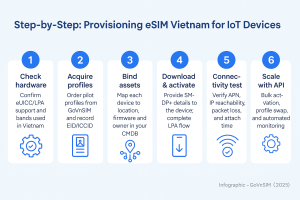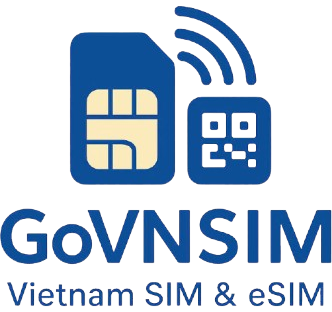eSIM Vietnam for IoT Devices: 2025 Practical Guide
eSIM Vietnam for IoT devices gives teams a reliable way to connect sensors, trackers, meters, kiosks, and industrial controllers without handling physical SIM cards. This guide explains what eSIM is, how to pick the right network in Vietnam, how to provision at scale, key security practices, costs versus plastic SIMs, and a field-tested case study your stakeholders can trust.
🚀What is eSIM for IoT?
eSIM (embedded SIM) is a rewritable chip soldered onto the device PCB. It stores multiple carrier profiles and supports secure, remote provisioning—no SIM tray, no site visit. For Internet of Things workloads, that means less downtime, fewer tamper points, and simpler rollouts across thousands of endpoints. The GSMA eSIM standard (eUICC with SM‑DP+/SM‑SR) defines how profiles are downloaded and activated over the air, which is exactly why eSIM Vietnam for IoT devices is gaining traction from utilities to logistics.
📡Why choose eSIM Vietnam for IoT devices?
- Remote lifecycle: Activate, suspend, or switch profiles via API—no truck rolls.
- Security by design: Encrypted profiles and sealed enclosures reduce SIM theft.
- Scalability: From 10 test units to 10,000+ production devices.
- Footprint: Nationwide 4G/5G coverage from major Vietnamese carriers.
🗺️Best networks for IoT in Vietnam
| Carrier | Coverage pattern | Typical IoT fit |
|---|---|---|
| Viettel | Nationwide, strong rural | Utilities, agriculture, nationwide telemetry |
| MobiFone | Urban/suburban density | Retail POS, city fleets, kiosks |
| VinaPhone | Nationwide | Interactive apps needing stable latency |
Run site pilots before scale-up: log RSRP/RSRQ/SINR for at least a week at representative locations (urban, suburban, rural). This de‑risks your eSIM Vietnam for IoT devices rollout under real conditions (peak hours, bad weather).
⚙️Step‑by‑step provisioning

- Check hardware: Confirm eUICC/LPA support and bands used in Vietnam.
- Acquire profiles: Order pilot profiles from GoVnSIM and record EID/ICCID.
- Bind assets: Map each device to location, firmware, and owner in your CMDB.
- Download & activate: Provide SM‑DP+ details to the device; complete LPA flow.
- Connectivity test: Verify APN, IP reachability, packet loss, and attach time.
- Scale with API: Bulk activation, profile swap, and automated monitoring.
🔐Security best practices
- Use Private APN + VPN so devices never touch the public internet directly.
- Require certificate‑based auth (mTLS) from device to cloud; rotate keys.
- Alert on anomalies: attach failures, sudden data spikes, silent devices.
- Stage firmware updates and enable safe rollback to avoid mass outages.
📈Case study: smart meters in Hanoi
A municipal utility migrated 20,000 meters to eSIM Vietnam for IoT devices. Remote provisioning eliminated most site revisits, while a private APN kept telemetry off the public internet. Over the first operating season, they cut truck rolls by ~80% and improved outage response because meters self‑reported events in near real time.
💰eSIM vs physical SIM (cost & ops)
| Aspect | eSIM (eUICC) | Physical SIM |
|---|---|---|
| Provisioning | Over‑the‑air (SM‑DP+) | Manual swap on site |
| Tamper risk | Low (sealed device) | Higher (removable card) |
| Scaling | API‑driven, automated | Logistics heavy |
| Ongoing OPEX | Lower at fleet scale | Higher (truck rolls) |
In short, eSIM Vietnam for IoT devices shifts cost from field labor to software automation—exactly what ops teams want for predictable growth.
❓FAQ
Can I switch carriers without visiting devices?
Yes. That’s the core advantage of eSIM: download and enable a new profile remotely.
Does it work in rural areas?
Yes. Prioritize Viettel for wide rural coverage and always validate signal metrics in pilots.
Do most IoT devices need SMS?
No. Telemetry is usually IP data. Keep SMS only for specific control or compliance needs.
Start your pilot with GoVnSIM
Kick off with 10–50 data‑only profiles, run a 14‑day site test, then scale via API with confidence. If a subset requires SMS, we’ll help you evaluate options.
Contact: WhatsApp: +84 98 307 49 15 · LINE: anyaxiaoying · Email: info@govnsim.com
